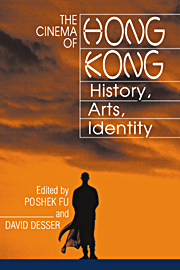Book contents
- Frontmatter
- Contents
- List of Contributors
- Acknowledgments
- Introduction
- Chronology of Hong Kong Cinema
- PART I HISTORY
- 1 The Kung Fu Craze: Hong Kong Cinema's First American Reception
- 2 The American Connection in Early Hong Kong Cinema
- 3 The 1960s: Modernity, Youth Culture, and Hong Kong Cantonese Cinema
- 4 The 1970s: Movement and Transition
- PART II ARTS
- PART III IDENTITY
- Index
4 - The 1970s: Movement and Transition
Published online by Cambridge University Press: 05 June 2012
- Frontmatter
- Contents
- List of Contributors
- Acknowledgments
- Introduction
- Chronology of Hong Kong Cinema
- PART I HISTORY
- 1 The Kung Fu Craze: Hong Kong Cinema's First American Reception
- 2 The American Connection in Early Hong Kong Cinema
- 3 The 1960s: Modernity, Youth Culture, and Hong Kong Cantonese Cinema
- 4 The 1970s: Movement and Transition
- PART II ARTS
- PART III IDENTITY
- Index
Summary
In 1970, mainly on the strength of Mandarin-language kung fu films, the Hong Kong cinema was poised to make a spectacular entry into the international cinema marketplace. By 1979, Mandarin-language cinema was dead, replaced not only by a new form of kung fu cinema, but by a veritable new wave of filmmaking. How did the Hong Kong cinema of the 1970s change so drastically over the course of the decade? How did a cinema so seemingly preoccupied with the production of genre films give rise to the critically acclaimed Hong Kong New Wave?
The links between the New Wave and the rest of Hong Kong cinema are not very obvious. The domination of kung fu films and the superstar status of Bruce Lee seem a far cry from the socially meaningful pictures that reflected contemporary society and were the hallmarks of the New Wave. The almost total critical disparagement of kung fu films, save for the work of King Hu, whose Touch of Zen (actually made in Taiwan for a Taiwanese production company) won a prize at the Cannes Film Festival in 1975, made the New Wave seem a unique and far different sort of film than the West had yet seen from Hong Kong. Yet, as we will see, the kung fu genre could not entirely be quarantined from the developments taking place all around it within the film industry.
- Type
- Chapter
- Information
- The Cinema of Hong KongHistory, Arts, Identity, pp. 90 - 110Publisher: Cambridge University PressPrint publication year: 2000
- 4
- Cited by

